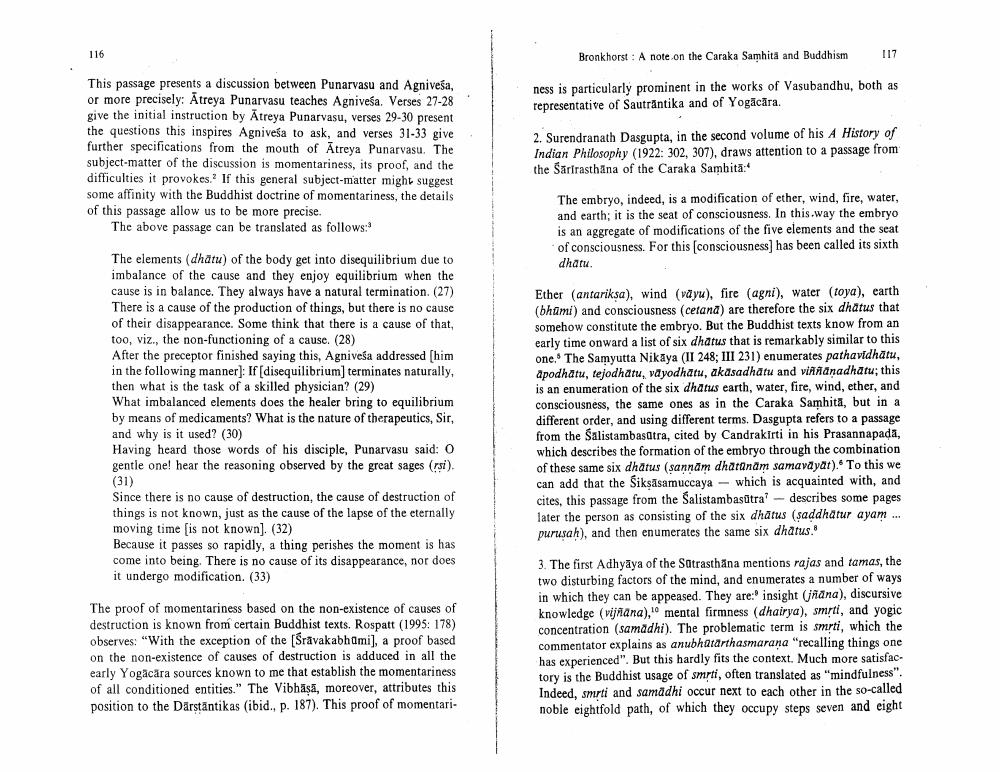Book Title: Note On Caraka Samhita And Buddhism Author(s): Johannes Bronkhorst Publisher: Johannes Bronkhorst View full book textPage 2
________________ 116 Bronkhorst: A note on the Caraka Samhita and Buddhism 117 ness is particularly prominent in the works of Vasubandhu, both as representative of Sautrantika and of Yogacara. This passage presents a discussion between Punarvasu and Agniveša, or more precisely: Atreya Punarvasu teaches Agniveśa. Verses 27-28 give the initial instruction by Atreya Punarvasu, verses 29-30 present the questions this inspires Agniveśa to ask, and verses 31-33 give further specifications from the mouth of Atreya Punarvasu. The subject matter of the discussion is momentariness, its proof, and the difficulties it provokes? If this general subject matter might suggest some affinity with the Buddhist doctrine of momentariness, the details of this passage allow us to be more precise. The above passage can be translated as follows: 2. Surendranath Dasgupta, in the second volume of his A History of Indian Philosophy (1922: 302, 307), draws attention to a passage from the Särirasthāna of the Caraka Samhita:* The embryo, indeed, is a modification of ether, wind, fire, water, and earth; it is the seat of consciousness. In this way the embryo is an aggregate of modifications of the five elements and the seat of consciousness. For this (consciousness) has been called its sixth dhatu The elements (dhatu) of the body get into disequilibrium due to imbalance of the cause and they enjoy equilibrium when the cause is in balance. They always have a natural termination. (27) There is a cause of the production of things, but there is no cause of their disappearance. Some think that there is a cause of that, too, viz., the non-functioning of a cause. (28) After the preceptor finished saying this, Agniveśa addressed him in the following manner]: If [disequilibrium) terminates naturally, then what is the task of a skilled physician? (29) What imbalanced elements does the healer bring to equilibrium by means of medicaments? What is the nature of therapeutics, Sir, and why is it used? (30) Having heard those words of his disciple, Punarvasu said: O gentle one! hear the reasoning observed by the great sages (ri). (31) Since there is no cause of destruction, the cause of destruction of things is not known, just as the cause of the lapse of the eternally moving time is not known). (32) Because it passes so rapidly, a thing perishes the moment is has come into being. There is no cause of its disappearance, nor does it undergo modification. (33) Ether (antariksa), wind (vayu), fire (agni), water (toya), earth (bhami) and consciousness (cetana) are therefore the six dhatus that somehow constitute the embryo. But the Buddhist texts know from an early time onward a list of six dhatus that is remarkably similar to this one. The Samyutta Nikaya (II 248; III 231) enumerates pathavidhatu, apodhatu, tejodhatu, va yodharu, akasadharu and vinaanadhatu; this is an enumeration of the six dhatus earth, water, fire, wind, ether, and consciousness, the same ones as in the Caraka Samhita, but in a different order, and using different terms. Dasgupta refers to a passage from the Salistambasatra, cited by Candrakirti in his Prasannapada, which describes the formation of the embryo through the combination of these same six dhatus (sannam dharanam samavayat). To this we can add that the Siksasamuccaya - which is acquainted with, and cites, this passage from the Salistambasatral-describes some pages later the person as consisting of the six dhatus (saddhatur ayam... purusah), and then enumerates the same six dhatus. The proof of momentariness based on the non-existence of causes of destruction is known from certain Buddhist texts. Rospatt (1995: 178) observes: "With the exception of the Sravakabhami), a proof based on the non-existence of causes of destruction is adduced in all the early Yogacara sources known to me that establish the momentariness of all conditioned entities." The Vibhasa, moreover, attributes this position to the Darstāntikas (ibid., p. 187). This proof of momentari 3. The first Adhyāya of the Satrasthana mentions rajas and tamas, the two disturbing factors of the mind, and enumerates a number of ways in which they can be appeased. They are: insight (Rana), discursive knowledge (vijnana)," mental firmness (dhairya), smrti, and yogic concentration (samadhi). The problematic term is smrti, which the commentator explains as anubhatarthasmarana "recalling things one has experienced". But this hardly fits the context. Much more satisfactory is the Buddhist usage of smrti, often translated as "mindfulness". Indeed, smrti and samadhi occur next to each other in the so-called noble eightfold path, of which they occupy steps seven and eightPage Navigation
1 2 3 4
